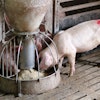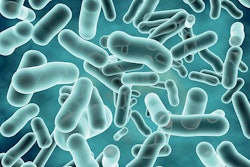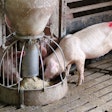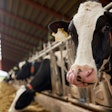
Hannah Tucker, ruminant technical service manager with Novus International, explains what’s going on with a key ingredient that supports milk fat production in dairy cows.
PODCAST: Palmitic acid price, supply challenge dairy producers (8:12)
Ann Reus: Hello and welcome to the Feed Strategy podcast. I’m your host, Feed Strategy senior reporter Ann Reus.
As dairy producers are already dealing with high input costs, they have one more thing to worry about: palmitic acid prices are rising too. According to Novus International, palmitic acid prices in the U.S. have risen 43% in the past 12 months. There is also concern about supply of the ingredient, which is used to support milk fat production in dairy cows.
In this podcast, I talk to Hannah Tucker, ruminant technical service manager with Novus, about what’s going on with palmitic acid.
First, can you explain what palmitic acid is and how it’s used in dairy production?
Hannah Tucker: Sure. So for palmitic acid, it is a C16:0 fatty acid. And because of this, it has a specific profile that will go into the cow when fed, and then go almost directly to the mammary gland to be part of butterfat. It’s the largest component of butterfat as a percentage. And for butterfat, it’s in a triglyceride form. But with these fatty acids, they have to be put into a glycerol backbone. And so that’s where the fatty acid will sit. And so it’s a major part of the butterfat, so it’s really important for the cow being able to optimize the amount of butterfat that will be produced. And since it’s very specific, it comes from a palm source that’s mostly made in Indonesia. And the colloquial term that we use in the dairy industry is palm fat, but we’re specifically talking about the palmitic acid as the fatty acid for that C16.
Reus: And like many things, palmitic acid prices are rising. Can you tell me why this is happening?
Tucker: So, there’s a couple of reasons why the prices are rising. We’ve been tracking this for a while now. And part of it has been the global shutdown and trying to get products here, there and everywhere, since we’re a global economy. Also dealing with the Ukrainian war that’s going on as well, that’s hindering agriculture overall. And also, within Indonesia itself, since it’s one of the major contributors for this product, there’s been a shutdown of exports that’s recently been opened. So that’s been helping to alleviate prices. But because of that shutdown on exports, that has actually hindered the price even more. And it’s not just for dairy cows that palm is fed. It also goes into things that are consumed by humans, such as cooking oils. And because of this demand coming from other areas, that’s also increased the price as other vegetable oils are also increasing and there’s just a scarcity going on globally.
Reus: What do these higher prices mean for dairy producers, who are already experiencing higher costs in other areas of production?
Tucker: So palm fat has been used widely in the industry because it has almost instantaneous impact on butterfat. So, for easy math, I’m going to say, if we feed a pound of palmitic fat, that means that we’re going to see a 30% increase in butterfat. So, because it’s used so widely, and the prices are going up, the ROI is starting to shift down. So even though we’ve seen an increase in butterfat prices for year over year, just to let people know, there’s been an increase of 56% for butterfat. So currently, it was prices coming out of the USDA, it’s $3.10 per pound, which is one of the highest prices that we’ve seen in a while. And based on what economists are saying, this is not going to trend downward anytime soon. Even with these high prices of butterfat, the high prices of palmitic fat is not returning the ROI for the amount of total yield of butterfat that’s going to be given to the dairy farmer.
Reus: What can producers do to counter the effects of high palmitic acid prices?
Tucker: So there’s a couple of different ways that farmers can go about working with their butterfat. And I am going to put in the caveat right away that it’s dependent on what the goals are of individual farms, because this can vary so widely. That’s what is great about the dairy industry, but also makes it hard for scientists like me to come in and give you an exact answer because it’s going to depend from farm to farm that live across the street from one another. But getting back to the fact of what can they do for increasing butterfat, there’s a couple of different arenas that they can work on. One of those is with management, you know, so avoiding slug feeding of the cows working with your nutritionist to really have what they’ve put on paper being fed to the cows so that the consistency of the TMR is the same across the whole bunk. And working with the veterinarians as well for the management of the animals, making sure that they’re feeling comfortable that they have, especially during this heat, cooling-down periods. And then there’s other avenues on the nutrition side, specifically, talking about a molecule called HMTBa that has an impact on butterfat as well. And that’s, my company Novus International, sells a product called ALIMET, or MFP, and the active ingredient of those products is HMTBa.
Reus: How might nutritionists approach alternative formulations without using palmitic acid?
Tucker: So it depends on how the rations are being made for the individual farms. For trying to increase butter fat, you can go about it a couple of different ways, because of the fact that there’s these different parts of butterfat dealing with the de novo or the short-chain fatty acids, and then the preform long-chain fatty acids. So with pulmonic fat, you’re increasing the total amount of long-chain fatty acids, versus the short-chain fatty acids in butterfat. To increase the amount of short-chain fatty acids, that’s going to be increasing the amount of acetate and butyrate, so the VFAs that are being produced in the rumen. And that’s going to be dependent on the type of fiber sources that are going into the ration. Now, I’m not going to lose track of the idea that the dairy is kind of limited in the type of forages that are going into the ration. So this is going to be difficult to deal with. However, another way that they can go about increasing butter fat as well is by making sure that there’s a limited amount of milk fat depression that’s occurring within the rumen. But that can be difficult to do because as we’re trying to push these cows for added production, there’s going to be this risk of milk fat depression occurring just because of the type of ingredients that we’re putting into the ration. However, there are ways to mitigate milk fat depression and its impact on butterfat. There’s been a lot of really great research coming out of Penn State, talking about the nutritional and non-nutritional factors that can go into this and breaking down how dairymen can work with their nutritionists and their veterinarians on mitigating these causes and making sure that we’re maximizing the amount of butterfat that’s being produced by cows, while still maximizing the amount of milk yield as well.
Reus: Well, Hannah, thank you so much for all of your insights today, and thanks for taking the time to talk to me.
Tucker: Thank you.
Reus: And thank you to the audience for listening. I’m Ann Reus for Feed Strategy.

















